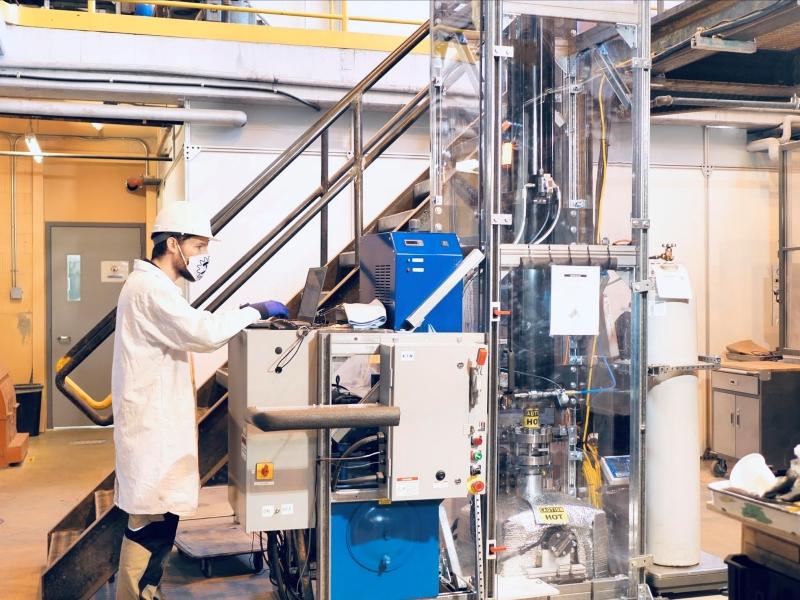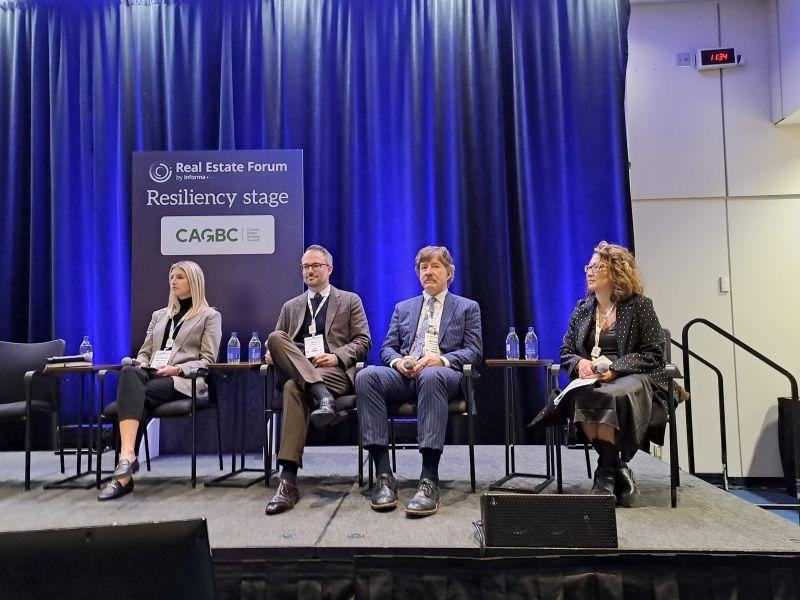The Government of Canada is trying to lead by example in meeting the country’s sustainability commitments. In an effort to show the private sector it can be done, Natural Resources Canada (NRC) is setting energy-efficiency and carbon reduction goals for its buildings higher than the bar set for the rest of the country.

Marie Lyne Tremblay, deputy director of the NRC’s Office of Energy Efficiency Buildings Division, speaks during the Ottawa Conflux 2018 conference. (Marc Shaw RENX)
During a talk at the Conflux Canada sustainability conference in Ottawa on May 10, deputy director of the NRC’s Office of Energy Efficiency Buildings Division, Marie Lyne Tremblay, outlined what the federal government is doing to reduce greenhouse gases (GHGs), both Canada-wide and in its own operations.
“The level of engagement and interest in meeting these targets is amazing. In the federal government, we have a lot of missionaries for sustainability and reduction in energy consumption and GHGs,” said Tremblay.
“If we can do it in a system that is truly like molasses when you want to change things, I’m sure that the private sector, which is nimble and responds to market constraints, can do it a lot faster than us.”
Tremblay manages a support program for federal facilities which aims to reduce emissions at least 40 per cent by 2030 and 80 per cent by 2050. Under the Pan Canadian Framework (PCF) on Clean Growth and Climate Change, Canada committed to lowering its GHG emissions by 30 per cent below 2005 levels by 2030.
More buildings, but lower emissions
Canada has already successfully decoupled the relationship between growth of floor space and growth of GHG emissions, she said. Since 2005, floor space in Canadian buildings has grown 17 per cent while GHGs have fallen by 12 per cent. Tremblay attributes this to the greening of the electrical grid and a combination of provincial, federal and market actions.
The PCF was signed by all provinces except Manitoba and Saskatchewan in 2016. The framework includes carbon pricing on emissions at $10 per tonne in 2018, then $10 per year increases until it reaches $50 per tonne in 2022. It also outlines initiatives to support clean technologies at the industrial level.
“This addresses a reduction of GHGs in the context of innovation, creating jobs and creating a strong economy. All that is coupled with a healthier, more sustainable and productive environment. There are wins in a number of sectors: industrial, buildings, residential and government.”
NRC creates Build Smart strategy
To manage its building sector efforts, NRC developed the Build Smart strategy. The vision of Build Smart is to achieve net-zero energy and net-zero emissions through steps funded by the federal government. Build Smart is based on the pillars of innovation in new buildings, a model code for existing buildings to be published in 2022 for provincial and territorial adoption, mandatory disclosure of energy usage by buildings, and equipment standards.
“Energy consumption is a desirable asset that needs to be made public,” said Tremblay. “We’ll continue to be more stringent on performance.”
By providing more information to potential tenants and buyers, the hope is to have owners and managers pay more attention to the performance of their buildings, seek out and share ways to improve performance.
“We think that homes and buildings can save between 30 and 55 per cent in comparison to standard builds. Of course, this is a big spread and depends on a lot of factors, but there is real economic value in doing this,” said Tremblay.
“We can build to net zero now. Everybody knows that, but in the future we need to reduce the incremental cost of building to a higher performance.”
The federal government is investing $182 million in energy-efficiency projects, to address climate change and improve how homes and buildings are designed. More than $48 million will go toward implementing new building codes and investing in new net-zero-energy-ready buildings to build confidence through real-world demonstrations of the benefits.
$2B low carbon economy fund
Another $2 billion is earmarked for the low carbon economy fund available for provinces and territories to enhance or create their own programming geared towards meeting the GHG reduction targets. There is also funding available for the research and development required by these projects to make them accessible and affordable.
The government has set additional sustainability targets for itself in addition to GHG reductions. All new federal buildings will be carbon-neutral by 2022, all electricity consumed by government facilities will be clean energy by 2025, those facilities will be used to test innovation and start the discussion on climate change resiliency, and government vehicle fleets will soon be zero-emission.
“The way the federal government procures its services and its goods will change. We need to change. We need to take into consideration GHGs and resources. It’s a transformative commitment, far beyond looking at the energy bill at the end of the month,” said Tremblay.
There are some notable exceptions, though. Emissions created by national security, such as military vehicles, are not being tracked the way non-military facilities are. Regardless of the exemption, Tremblay said the government is seeking ways to also reduce military emissions.
By setting most federal sustainability goals for implementation by 2022, there will be time to analyze what does and doesn’t work before other sectors run up on the 2030 target date. Build Smart data should go a long way to showing these changes in practice, giving owners and builders information on how these solutions might also work for them.







